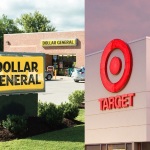
Just because you can afford to spend more for your groceries and household items, doesn’t mean you want to.
It’s a sure sign of a shaky economy when higher-income customers start doing more of their shopping in dollar stores. And according to one recent report, it’s already happening.
“Dollar stores are booming with high income shoppers switching to save,” the market research company Numerator is reporting. According to its latest data, sales at dollar stores are up 14% from the same time last year. The average dollar store shopper is spending 9% more per trip, but high-income shoppers are spending far more – 33% more than last year. That means higher-income shoppers are either visiting dollar stores more often, spending more when they’re there, buying more of their everyday goods at dollar stores, or all of the above.
“As the cost of everyday goods continues to rise, consumers are shopping around to find value,” Numerator CEO Eric Belcher said in a statement. “Many of these shifts, including high-income households trading down to dollar stores, are unexpected.”
Is it really unexpected, though? Even those with money, still like to save money.
“Tougher times for the consumer normally means that she needs us more, and we normally start to see a trade down once that occurs,” Dollar General CEO Todd Vasos told investors recently. He said Dollar General stores are beginning to see “a little higher-end consumer,” as inflation prompts more deal-seeking behavior, and gas prices keep more shoppers closer to home. “Shopping patterns are definitely changing,” he noted, “and we’re seeing it happen right before our eyes.”
It certainly happened during the last economic downturn. During the Great Recession that started in 2007, shoppers making more than $100,000 a year started showing up at dollar stores in greater numbers. Dollar stores responded by putting less of an emphasis on trinkets and bargains and more focus on everyday items like groceries and household necessities. In 2009, Nielsen found that pasta, cheese, soup and dried grains were among the fastest-growing categories in dollar stores. And you don’t have to be low-income to want a good deal on your everyday needs.
Unfortunately, Numerator also warns that dollar stores don’t always provide the best deals. Echoing their findings from earlier this year, Numerator found that “rising prices are disproportionately affecting the dollar channel.” All year so far, dollar stores and online retailers have been trading places as the shopping destinations experiencing the highest rate of inflation. This past month, Numerator found that prices at dollar stores were up 19.8% from the same time last year. That’s less than the 21.5% rate among online retailers, but far more than the 12.2% inflation rate in grocery stores and 9.9% at club stores.
But lower-income shoppers don’t always have the cash on hand to save money by buying in bulk at club stores. And shoppers at all income levels may not want to fill up the gas tank to stock up at often inconveniently-located warehouse stores, when they can grab a basket full of needed items for a lot less at their nearby neighborhood dollar store.
Vasos predicted that the trade-down effect that has more higher-income shoppers visiting Dollar General stores will “probably pick up steam” as the year goes on. And investment research firm Gordon Haskett says he’s probably right – otherwise he likely wouldn’t have moved forward with plans to announce his impending retirement last week. Gordon Haskett called that announcement “an indirect endorsement that the retailer is in a very good spot right now.”
So you may not necessarily get the best price-per-unit at a dollar store, though you’ll likely be able to spend less out of pocket for what you need right now. The bottom line is, if you’re financially secure enough that you have money to spend, and you choose to spend it in a dollar store – it seems you have a whole lot of company lately.
Image source: Dollar Tree











Many things like that – even if the packages are smaller, they can be cheaper per unit than larger ones at the bigger stores.
For instance – cups of apple sauce. A 4 Pack for $1 (or even $1.25, though they are still $1 at a couple stores with varying prices) is still a lower price per cup than a 6 pack in the supermarket for $2, and they are all store brands so no difference there.
A Dollar Tree (DT) is a bit farther than the two bigger major grocery stores, nearest to us, but it is in the same strip center as three ethnic markets.
So, between the everyday bargains at DT, like the same brand loaf of bread for $1.25 that I pay $5 for the bigger stores, shelf-stable milk, some spices, and a few other staples, and the ethnic markets that have fresh meats and vegetables for less than the bigger stores, it’s worth the extra mile or two drive to visit the DT.
Some say the cleaning products are watered down, but most of them work just as well for me as the more expensive brands. Same with many of the body washes and shampoos and other HBA items.
$1.25 LED light bulbs in a two-pack — they were previously $1 each, so that’s a better value than before the big price boost. Not always in stock, though, so we buy a few more when they are available. They are well made and last a long time — but not quite 20 years as they state on the box.
There is no fresh produce or meat at the DT, and it’s often a cluttered mess, but it’s worth it for those items. And, often there is no one in line to check out (despite DT not having self checkouts), so fast to get out of there. Certainly a price check is a rare event at the DT.
Parking, too, is almost always available right in front of the store.
It’s not the prettiest strip shopping center, but I am not living there — just shopping.